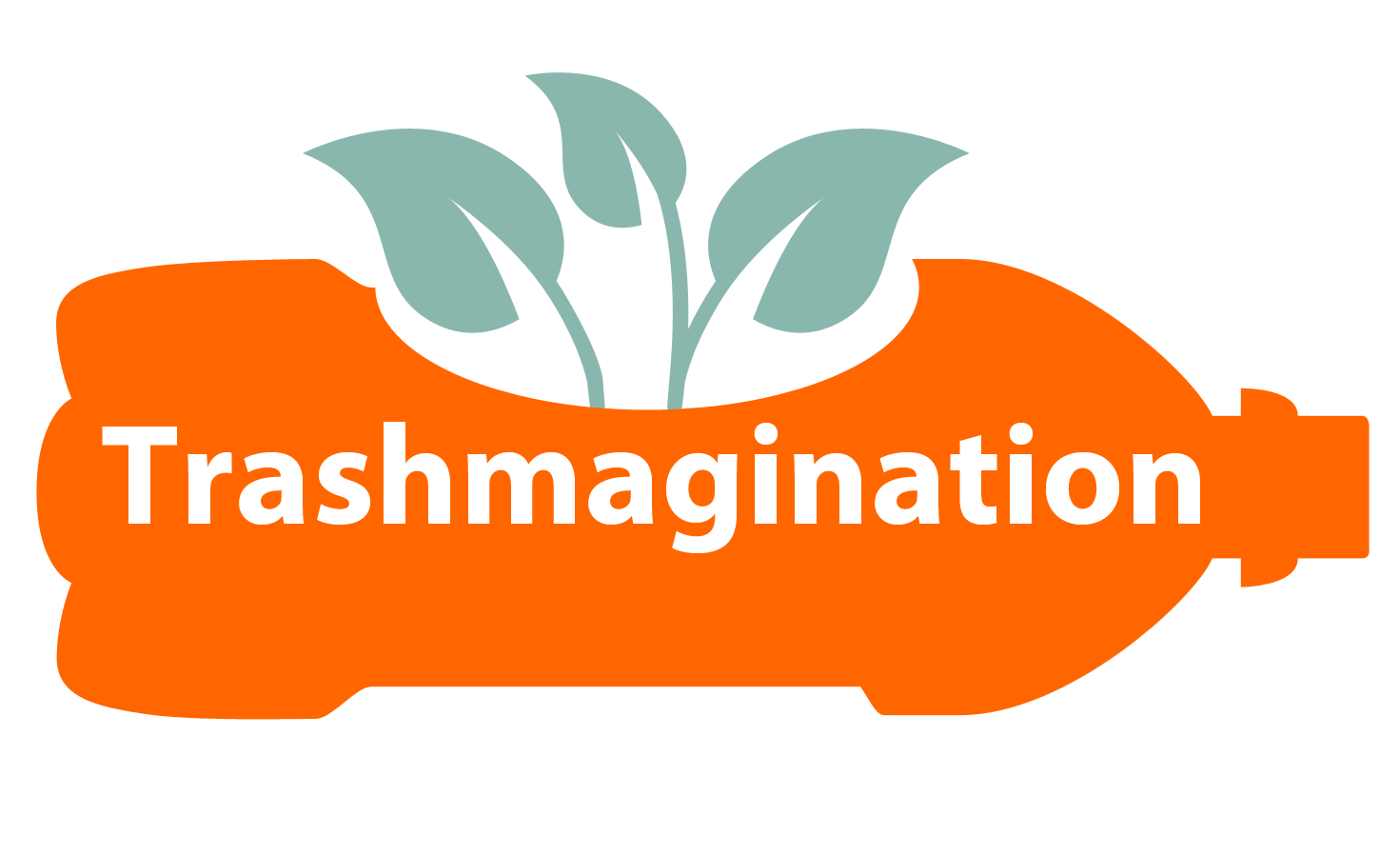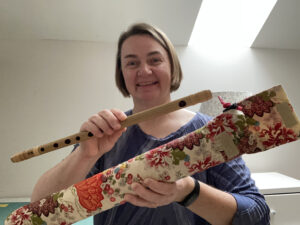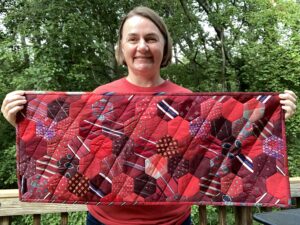If you spend time on Pinterest, you can quickly get overwhelmed by the number of items labelled as “recycled crafts.” The goal of this blog is to help you sort out the best ones.
I might be a “recycled craft snob.” I spent at least an hour reviewing the craft book section, and was unimpressed with most offerings. I have studied so many recycled craft ideas – I now appear to have a ranking system in my head. So why not share that system out loud and see how other people improve it?
Here’s my first attempt to write down what goes through my head when I am evaluating a recycled craft.
1) Is the recycled craft useful?
Many recycled crafts, especially those designed for children, are a glued-together pile of trash. Yes, it looks like an owl, but it’s not useful. We parents are stuck trying to figure out how long we need to keep it before it gets photographed and tossed. In most cases, my children do not have a deep attachment to those crafts, so luckily, it’s not a long time.
My favorite recycled crafts are like flexible containers crocheted from plastic bags. They take plastic bags, which are detestable and persistent, and transform them into something sturdy and helpful.
There are a LOT of recycled crafts that are called “art” and are not necessarily “useful.” It is lovely that artists gain inspiration from trash. But when I teach recycled craft concepts, I want people to also learn values of reducing and re-using – replacing things they would otherwise buy new.
Likewise, it is tricky to decide whether home decor or jewelry are “useful.” Certainly we want wall hangings to make our homes cheery. We appreciate jewelry because it makes us feel special and attractive. But I would give higher points to a craft that replaces something I would buy for everyday use, over a home decoration or jewelry item.
Crafts that replace purchasing something new that I use often will earn 10 points. Crafts that add a bit of fun to your decor or wardrobe earn 3 points.
2) Will the recycled craft be used for educational or celebratory purposes?
I made a vest from recycled juice pouches. I don’t wear the vest often (except on Earth Day). I wear it when I am working with children or hosting a trash fashion show.
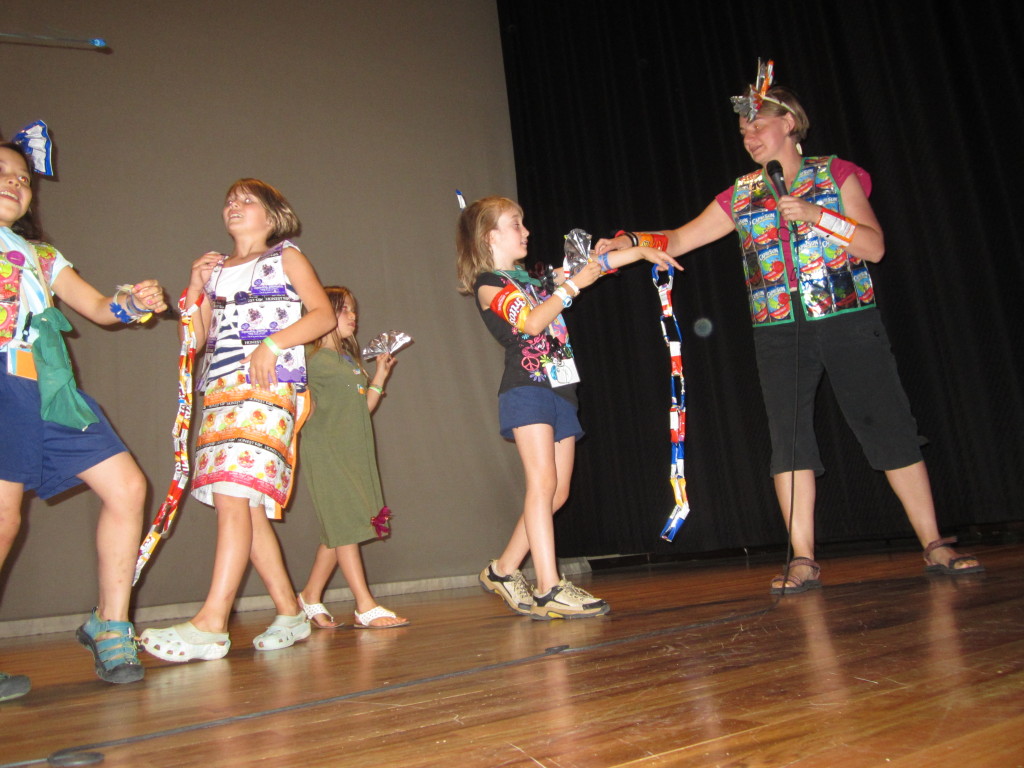
Likewise, I view every Halloween as an opportunity to remind people that we used to make our own costumes out of trash. We didn’t go to the party store and pay a pitiful sum for a costume that likely is not sewn in the best circumstances.
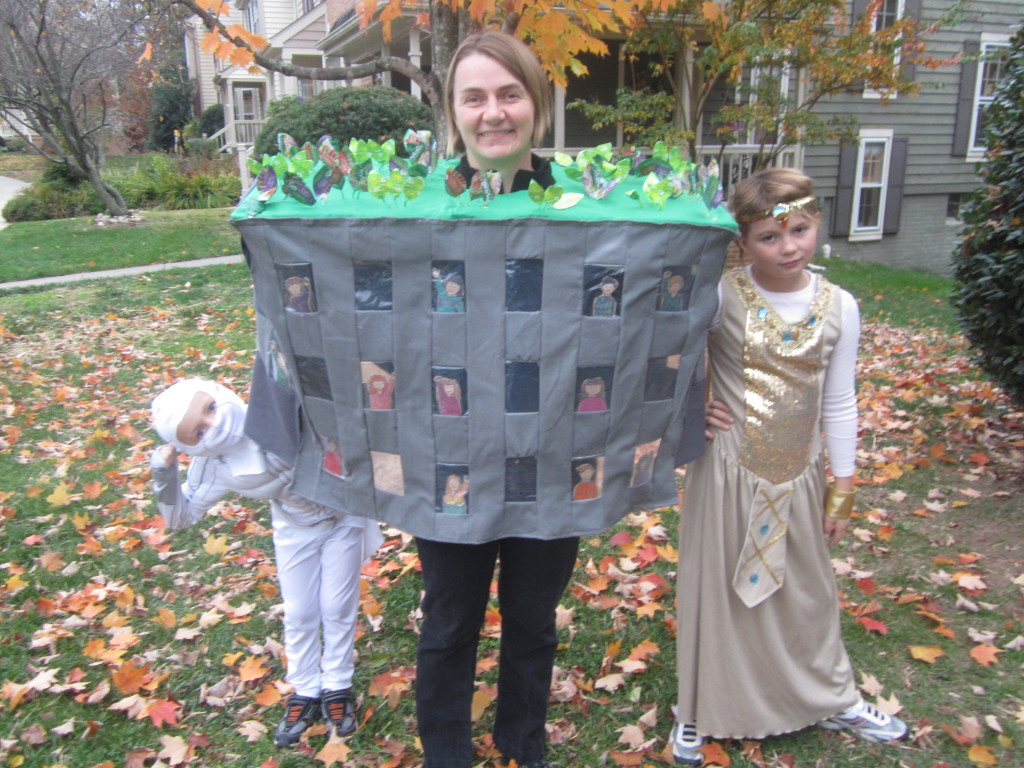
Another type of craft in this category is one that changes your worldview about a material item. Look at the lottery ticket flowers made by Alex Lockwood. The flowers make you re-think what you can do with paper. How did he fold all those things? It serves an educational purpose because it makes you want to understand the material and methodology.
Educational and celebratory crafts that you use repeatedly earn 5 points. Those that have one usage earn 2 points.
3) How strong is the recycled craft?
I can’t tell you how many crafts come home from school in my children’s backpacks already broken. They are “insta-trash.” They are the junk food of crafts. They perpetuate disposable thinking, rather than Trashmagination thinking.
I place more value on a recycled craft put together with string and screws than those with tape and glue.
Strong crafts survive a trip home on a school bus. They can fall off a table. They can get squished under a pillow when they are brought to bed and someone rolls over at night.
A recycled craft has a better chance of being loved if it can survive more than a day.
Strong recycled crafts earn four points.
4) What percentage of the recycled craft is made from items that would have gone to landfill?
Some recycled crafts are listed as recycled because one ingredient is recycled. The rest is made from supplies purchased from craft stores etc. For example, if you take an old CD and glue a bunch of pompoms to make a fluffy kitty magnet, those pompoms were not on their way to landfill – at least not before you glued them on.
If you empty five paint cans in the process of painting toilet paper tubes, you have generated more trash than if you just put the tubes in the paper recycling bin.
Another factor in this rating is that some items are more commonly recycled in the United States. For example, toilet paper tubes are commonly used in recycled crafts, but in my rankings, they are an easily recycled items. Most municipalities have paper recycling. Contrast that with juice pouches. You can collect juice pouches and mail them to Terracycle (earning money for your favorite charities) but that takes a lot more work than most people are willing to undertake. That’s why crafts which use juice pouches get more points than those from toilet paper tubes.
Crafts earn points on a sliding scale for this category, starting with four points if it is 100% landfill-saved, down to three, two, one – depending on the percentage of non-recycled input items.
5) Does the recycled craft encourage imaginary play – while making it or later?
If a recycled craft can entertain a child for many hours, it gets points. One example is a curtain I made from sewing together sheer curtain samples and ribbons. You hang it from a tree branch and voila! It is a fort, or a stage, or a princess castle. It has open-ended uses. Making toys such as my daughter’s “Yarn Barbies” (stuffed shapes with yarn hair) get points in this category.
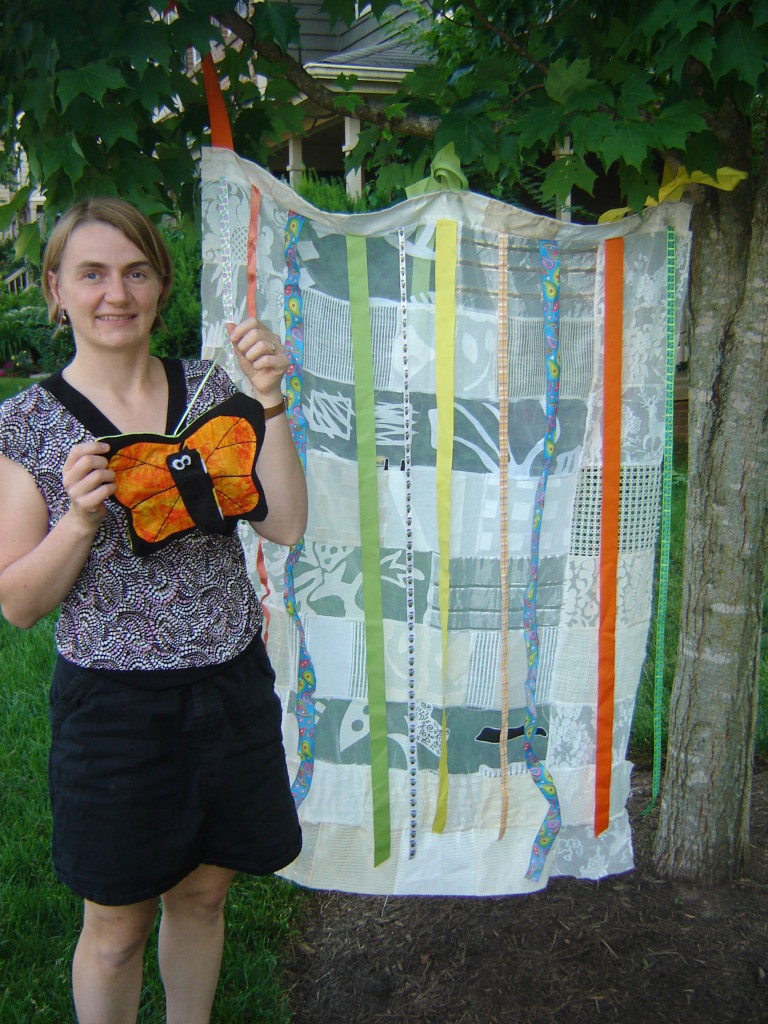
Remember that gift certificate that I mentioned at the beginning? The book I finally purchased was called Made to Play! Handmade Toys and Crafts for Growing Imaginations by Joel Henriques. (I’m overdue to write a blog about this lovely book). Everything he makes would earn points in this category.
Imaginary play recycled crafts earn 3 points.
6) When I tire of this recycled craft, is it easy to decompile and recycle the components?
Having decomposition as a crafter’s goal can change how you design your craft. You may choose to thread together items rather than glue them, or you may try to keep components more “intact” so they could be used for other things.
Glued crafts are often left with a crusty layer if you decompile them, and sometimes you can still recycle the components, but ewww. Another example of a material that doesn’t decompile – melted plastic.
As an aside, this is also why I like futons over couches and mattresses. Taking apart an couch and finding uses for all the components is extremely difficult. Futon decomposition – likely a 10 minute effort. A few years ago, I took apart a mattress and box spring. The task took all day and required many trips to various places to recycle it all.
Crafts that decompile easily earn 2 points.
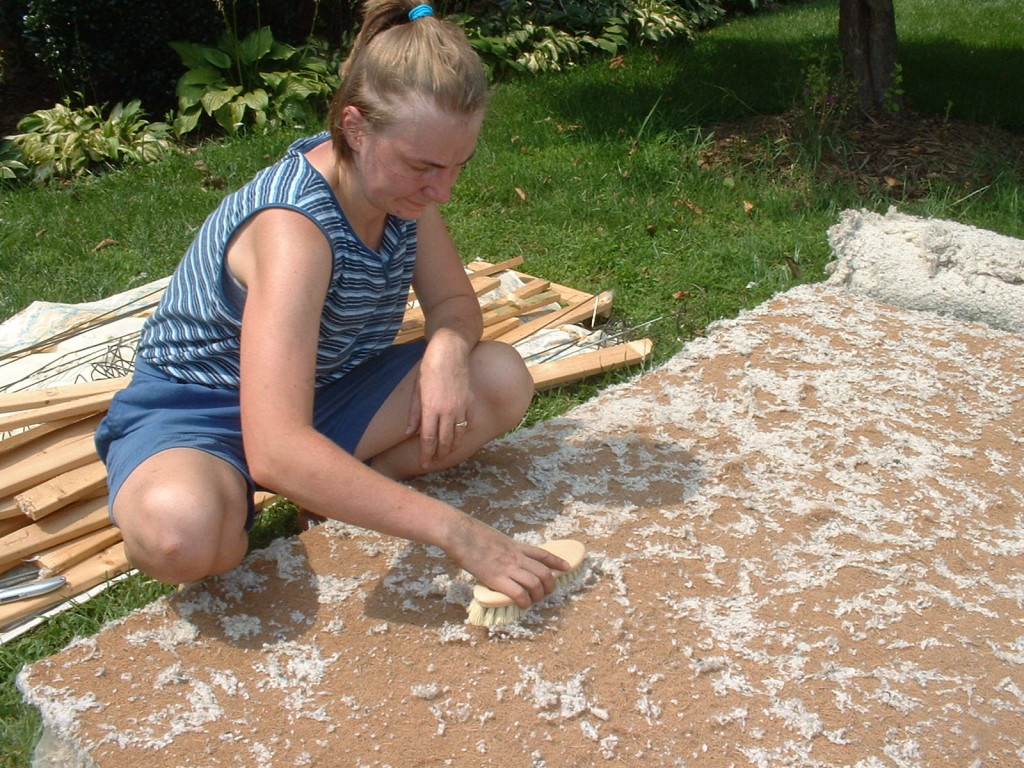
How difficult is it to make this recycled craft?
If I’m teaching kindergartners, some crafts are just not going to work. So sometimes recycled crafts get made just because they suit the audience. On this topic, I will not award points. It’s just a factor in Trashmagination education.
Summary of the Recycled Craft Rating Categories and Points Values
| Recycled Craft Rating Categories | Maximum Points |
| Useful? | 10 – everyday use; 3 – fun, beautiful |
| Educational or Celebratory? | 5 – repeated use, 2 – one time use |
| Strong | 5 |
| % of ingredients saved from landfill | 4>>1 (sliding scale) |
| Encourages imaginary play | 4 |
| Easy decomposition | 2 |
| MAXIMUM SCORE | 30 |
Applying this to Real Crafts
I am evaluating crafts for the Family Nature Summit in Maine. I will apply my rating system to some top candidates. These all score pretty highly because they have already been through my screening process. I would note that kid-friendly recycled crafts tend to have lower scores than those which adults can make because childrens’ fine-motor skills are less developed. They can’t make super complex things.
Idea #1 – Floating Faux Fish from Parents Magazine
| Recycled Craft Rating Categories | Maximum Points | Points for this Craft |
| Useful? | 10 – everyday use; 3 – fun, beautiful | 3 |
| Educational or Celebratory? | 5 – repeated use, 2 – one time use | 2 |
| Strong | 5 | 3 |
| % of ingredients saved from landfill | 4>>1 (sliding scale) | 3 |
| Encourages imaginary play | 4 | 3 |
| Easy decomposition | 2 | 2 |
| SCORE | 30 | 16 |
This craft gets high points for useful because I could see these fish decorating a home aquarium or bowl of water on a bathroom sink. From an educational perspective, it will make the kids look at bubble wrap and plastic containers differently. I think the kids will love seeing these floating and will get lot of fish drama ideas. But they cannot be manipulated that much for open-ended play.
Idea #2 – Reversible Cardboard Necklace from Julep
| Recycled Craft Rating Categories | Maximum Points | Points for this Craft |
| Useful? | 10 – everyday use; 3 – fun, beautiful | 3 |
| Educational or Celebratory? | 5 – repeated use, 2 – one time use | 5 |
| Strong | 5 | 3 |
| % of ingredients saved from landfill | 4>>1 (sliding scale) | 0 |
| Encourages imaginary play | 4 | 3 |
| Easy decomposition | 2 | 2 |
| SCORE | 30 | 16 |
This craft gets high points for imagination because the kids can design whatever they want, and wear it for whatever dramas they want. However, anything made with cardboard will tend to score lower because it is easy to recycle cardboard. Also, cardboard recycled crafts tend to end up in the trash.
Idea #3 – Shirt Backpack
| Recycled Craft Rating Categories | Maximum Points | Points for this Craft |
| Useful? | 10 – everyday use; 3 – fun, beautiful | 10 |
| Educational or Celebratory? | 5 – repeated use, 2 – one time use | 5 |
| Strong | 5 | 5 |
| % of ingredients saved from landfill | 4>>1 (sliding scale) | 1 |
| Encourages imaginary play | 4 | 1 |
| Easy decomposition | 2 | 0 |
| SCORE | 30 | 22 |
This idea gets high points, but it might not work for my young kid audience because it requires real sewing. It’s solvable though because I can do sewing in advance and leave other tasks for when we are together. Perhaps we can make it more open-ended and creative by having them decorate the backpacks – what about a little pocket on the front made from a plastic bag where they can store treasures? It gets a low points for ingredients saved from landfill because t-shirts tend to get passed along as rags, and it requires new ingredients such as the grommets.
That gives you an idea of how you might use the recycled craft rating system to evaluate your next crafting effort!
